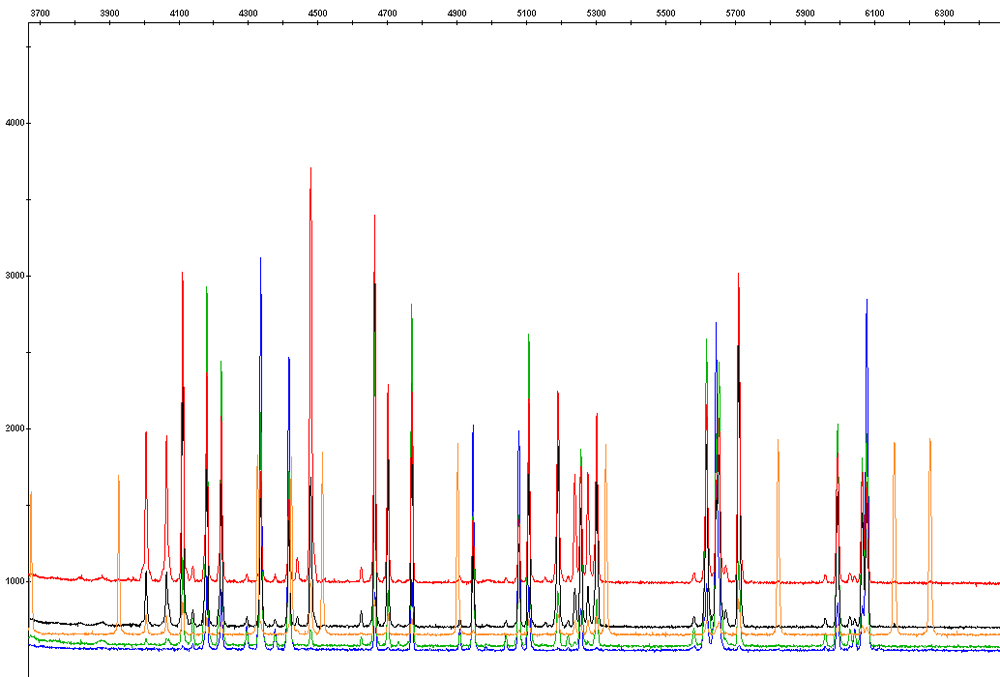|
|
Forensic DNA
Capillary Electrophoresis
 After the DNA in a sample has been copied via PCR, the various color coded fragments must be separated. This is accomplished via capillary electrophoresis. Capillary electrophoresis is the process in which samples are injected into a very thin capillary containing a gel (the inside diameter of which is approximately the width of a human hair) by using an electrical current. The DNA fragments that were copied during PCR will be forced to move through the gel inside the capillary where they will separate based on their sizes. The gel inside the capillary causes larger fragments of DNA to move slower than short fragments of DNA (short fragments with only a few repeats have a much easier time weaving through the gel than the longer fragments that have more repeats). As the sample moves through the column it will eventually pass by a laser and detector system. A laser beam will hit the color coded sample and cause this color to be detected by a camera within the detector system. The camera will register the color as it passes by and a computer hooked up to the system will create what is called an "electropherogram" based off of the data (as seen in the image below). Luckily, there are software programs available that assist analysts with reading electropherograms - which will be further explored under the "Analysis" tab to the left. After the DNA in a sample has been copied via PCR, the various color coded fragments must be separated. This is accomplished via capillary electrophoresis. Capillary electrophoresis is the process in which samples are injected into a very thin capillary containing a gel (the inside diameter of which is approximately the width of a human hair) by using an electrical current. The DNA fragments that were copied during PCR will be forced to move through the gel inside the capillary where they will separate based on their sizes. The gel inside the capillary causes larger fragments of DNA to move slower than short fragments of DNA (short fragments with only a few repeats have a much easier time weaving through the gel than the longer fragments that have more repeats). As the sample moves through the column it will eventually pass by a laser and detector system. A laser beam will hit the color coded sample and cause this color to be detected by a camera within the detector system. The camera will register the color as it passes by and a computer hooked up to the system will create what is called an "electropherogram" based off of the data (as seen in the image below). Luckily, there are software programs available that assist analysts with reading electropherograms - which will be further explored under the "Analysis" tab to the left.

|
|

 After the DNA in a sample has been copied via PCR, the various color coded fragments must be separated. This is accomplished via capillary electrophoresis. Capillary electrophoresis is the process in which samples are injected into a very thin capillary containing a gel (the inside diameter of which is approximately the width of a human hair) by using an electrical current. The DNA fragments that were copied during PCR will be forced to move through the gel inside the capillary where they will separate based on their sizes. The gel inside the capillary causes larger fragments of DNA to move slower than short fragments of DNA (short fragments with only a few repeats have a much easier time weaving through the gel than the longer fragments that have more repeats). As the sample moves through the column it will eventually pass by a laser and detector system. A laser beam will hit the color coded sample and cause this color to be detected by a camera within the detector system. The camera will register the color as it passes by and a computer hooked up to the system will create what is called an "electropherogram" based off of the data (as seen in the image below). Luckily, there are software programs available that assist analysts with reading electropherograms - which will be further explored under the "Analysis" tab to the left.
After the DNA in a sample has been copied via PCR, the various color coded fragments must be separated. This is accomplished via capillary electrophoresis. Capillary electrophoresis is the process in which samples are injected into a very thin capillary containing a gel (the inside diameter of which is approximately the width of a human hair) by using an electrical current. The DNA fragments that were copied during PCR will be forced to move through the gel inside the capillary where they will separate based on their sizes. The gel inside the capillary causes larger fragments of DNA to move slower than short fragments of DNA (short fragments with only a few repeats have a much easier time weaving through the gel than the longer fragments that have more repeats). As the sample moves through the column it will eventually pass by a laser and detector system. A laser beam will hit the color coded sample and cause this color to be detected by a camera within the detector system. The camera will register the color as it passes by and a computer hooked up to the system will create what is called an "electropherogram" based off of the data (as seen in the image below). Luckily, there are software programs available that assist analysts with reading electropherograms - which will be further explored under the "Analysis" tab to the left. 